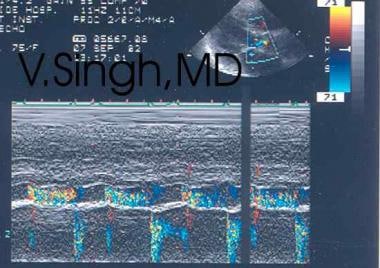Background
Aortic valve insufficiency results from leakage and backflow of blood that is ejected from the left ventricle (LV) into the ascending aorta back into the left ventricle.
Many mechanisms contribute to aortic valve insufficiency. These include abnormalities of the aortic valve leaflets and pathologies of the proximal aortic root. This article primarily focuses on aortic valve insufficiency caused by abnormalities in the aortic valve leaflets.
Anatomy of the aortic valve
The aortic valve is composed of 3 thin leaflets (ie, cusps) that project from the wall of the proximal ascending aorta. These leaflets and their respective sinuses of Valsalva are termed left, right, and noncoronary.
Embryologic development of the aorta
In the embryonic stage, the truncus arteriosus connects to the dorsal aspect of the aorta via 6 pairs of aortic arches. The separation of truncus arteriosus into 2 great arteries results from the fusion of the aorticopulmonary septum and the truncus septum. The semilunar valves and their related sinuses are created by absorption and the hollowing out of tissue at the distal side of the truncus ridges.
Many mouse single-gene-knockout models of truncus arteriosus have been reported (eg, Sox4 null, Tbx1 null, pax3Splotch), although only NFATc1 null and Sox4 null display absent semilunar cusps. Ablation of a particular region in the cranial neural crest also results in truncus arteriosus, at least in the chick.
Aortic valve insufficiency can be due to, or associated with, congenital heart disease.
Ventricular septal defect of the membranous (conoventricular) or conal septal (infundibuloventricular) types
Bicuspid (ie, bicommissural) aortic valve
Subvalvular aortic stenosis
Dysplasia of valve cusps, without fusion of commissures
Absence of 2 or 3 aortic valve leaflets
Acquired valvular aortic insufficiency
Causes of acquired aortic valve insufficiency include endocarditis, trauma, systemic diseases, and connective tissue syndromes. Systemic diseases that cause aortic valve insufficiency include the following:
Syndromes that lead to aortic valve insufficiency include the following:
Ehlers-Danlos syndrome, type IV
Recently, the percentage of individuals with aortic valve insufficiency caused by aortic root disease has been steadily increasing compared with the percentage of those with valvular disease. In fact, more than half of patients who present with pure aortic regurgitation (AR) without any associated cardiac anomalies have aortic valve insufficiency caused by aortic root disease. See the image below.
Aortic regurgitation. Color Doppler echocardiogram.

